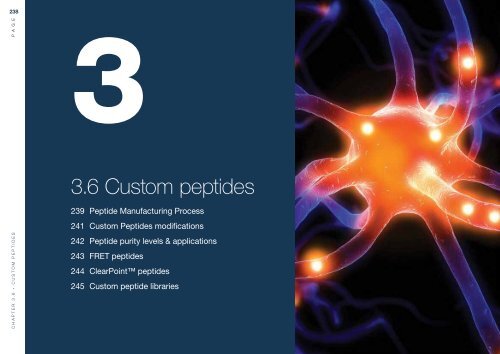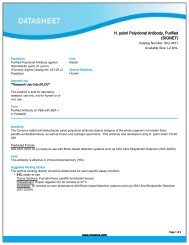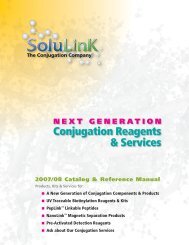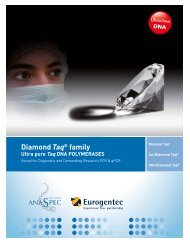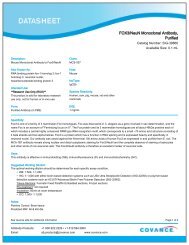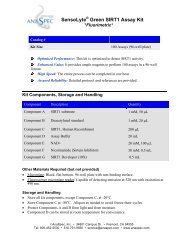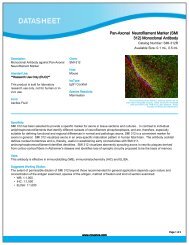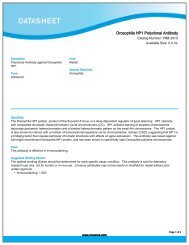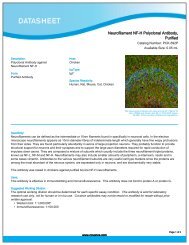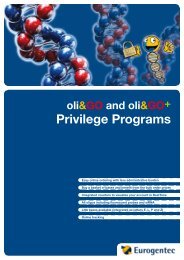3.6 Custom peptides - Eurogentec
3.6 Custom peptides - Eurogentec
3.6 Custom peptides - Eurogentec
You also want an ePaper? Increase the reach of your titles
YUMPU automatically turns print PDFs into web optimized ePapers that Google loves.
238<br />
P A G E<br />
ChAPtEr <strong>3.6</strong> » <strong>Custom</strong> PEPtidEs<br />
3<br />
<strong>3.6</strong> <strong>Custom</strong> <strong>peptides</strong><br />
239 Peptide Manufacturing Process<br />
241 <strong>Custom</strong> Peptides modifications<br />
242 Peptide purity levels & applications<br />
243 FRET <strong>peptides</strong><br />
244 ClearPoint <strong>peptides</strong><br />
245 <strong>Custom</strong> peptide libraries
Peptide manufacturing Process<br />
<strong>Eurogentec</strong> and Anaspec have combined their deep knowledge<br />
and yearly experience to further satisfy your needs in custom<br />
peptide synthesis, both in terms of Peptide length, modifications<br />
and synthesis scale (up to kg <strong>peptides</strong>).<br />
Sequence analysis<br />
our skilled chemists make feasibility evaluations based on software<br />
and our own internal database on all peptide sequences prior to<br />
synthesis. should any of these parameters be too low, you will be<br />
informed prior to the acceptance of your order:<br />
k difficult to synthesize sequences<br />
k hydrophobicity/ hydrophilicity plot: hoop-Woods and Kytedoolittle<br />
algorithms.<br />
k Antigenic index (Jameson-Wolf) and surface probability<br />
evaluations (in case of peptide for immunization)<br />
Peptide synthesis<br />
the automatic peptide synthesis starts from a special resin on<br />
which the whole peptide sequence is synthesized sequentially by<br />
stepwise addition of the different amino acids. the growing peptide<br />
chain stays fixed to the resin until the end of the synthesis. Each<br />
single amino acid addition consists of 3 individual reaction steps:<br />
deprotection, activation and coupling.<br />
Deprotection<br />
raw material consists of commercially available protected amino<br />
acids in which the alpha amino group is protected by the so-called<br />
FmoC group (9-Fluorenylmethyloxycarbonyl), while the reactive<br />
side chain is also protected to avoid secondary reactions.<br />
the decisive advantage of using FmoC is that it can be cleaved<br />
under relatively mild basic conditions using Piperidine.<br />
during the deprotection phase, Piperidine is used to remove the<br />
FmoC protection of the last amino acid of the elonging chain,<br />
leading to a free and reactive amino group that can react with the<br />
next amino acid to be added to the chain.<br />
Activation<br />
the next amino acid to be added, fully protected, is then introduced<br />
in large excess. in order to allow for a quick reaction, its carboxyl<br />
group is to be activated. the activator transforms the carboxylic<br />
acid to a so-called active ester.<br />
Coupling<br />
this active ester in turn reacts on the free amino group of the<br />
elonging chain, resulting in the formation of a new amide bond and<br />
thus to the addition of one amino acid to the chain. the whole<br />
process is subsequently repeated with the next amino acid.<br />
Completion of synthesis<br />
After addition of all amino acids to the chain, the peptide is present<br />
in protected form and still linked to the resin. Piperidine is then used<br />
to remove the remaining FmoC protection at the end of the chain<br />
and tFA is applied both to remove side chain protections and to<br />
free the peptide from the resin.<br />
the figure beside summarizes the peptide synthesis process.<br />
specifications<br />
Length From 6 to 100 a.a.<br />
Synthesis scale From µg to Kg<br />
Modifications More than 100 !<br />
Purification 5 purity levels from crude<br />
to 98 % pure <strong>peptides</strong><br />
Quality control HPLC and MALDI-TOF MS<br />
Format Dried<br />
Documentation Technical Data Sheet<br />
Shipping Room temperature<br />
Cleavage<br />
Peptide<br />
Resin<br />
Deprotection<br />
Synthesis<br />
scale<br />
Coupling<br />
Amino<br />
Acid<br />
Activation<br />
Figure 1 : Peptide synthesis process<br />
239<br />
P A G E<br />
ProtEomiC soLutioNs » <strong>Custom</strong> PEPtidEs
240<br />
P A G E<br />
ChAPtEr <strong>3.6</strong> » <strong>Custom</strong> PEPtidEs<br />
Purification and QC<br />
the identity of all <strong>peptides</strong> is analysed by mALdi mass<br />
spectrometry. Comparison of the theoretical molecular<br />
weight with the experimentally determined molecular<br />
weight confirms the absence of amino acid deletions or<br />
double couplings.<br />
the Purity of all non-crude <strong>peptides</strong> is analysed by<br />
reverse-Phase hPLC (rP-hPLC). Precipitated <strong>peptides</strong><br />
are analysed on a Waters Alliance, rP-hPLC instrument,<br />
equipped with an auto-sampler for continuous analysis.<br />
other tests such as sequencing and Amino acid analysis<br />
are available on demand.<br />
Delivery<br />
in order to ensure short delivery time, all <strong>peptides</strong> are<br />
shipped by express courier. 70 % pure <strong>peptides</strong> are<br />
shipped lyophilised within 10–15 working days of receipt of<br />
the order. For purified <strong>peptides</strong> (> 85 % and > 95 % pure),<br />
5 additional days are required.<br />
After purification and corresponding quality control, the<br />
peptide is lyophilised, weighted and shipped. if ever we<br />
were unable to obtain the ordered quantity, a resynthesis<br />
is started immediately and the additional quantity delivered<br />
afterwards.<br />
the peptide is always shipped together with:<br />
k the hPLC analysis profile<br />
k the mass spectrum<br />
k A data sheet containing useful information (molecular<br />
weight, isoelectric point,…)<br />
k information about solubilization and storage<br />
<strong>Eurogentec</strong> products are guaranteed to meet or exceed<br />
the specifications listed. this warranty is limited to the<br />
replacement of the product, no other warranty, expressed<br />
or implied is provided by <strong>Eurogentec</strong>. our products are<br />
sold for research and laboratory use only and are not to be<br />
administered to humans or used for medical diagnostics.<br />
Working with <strong>peptides</strong><br />
the first choice solvent for most <strong>peptides</strong> is ultra-pure<br />
water. if the peptide does not dissolve easily, sonication<br />
may help. dilute acetic acid or ammonium hydroxide may be<br />
necessary to dissolve basic or acidic <strong>peptides</strong>, respectively.<br />
For <strong>peptides</strong> which are not dissolved by these methods,<br />
guanidinium chloride or acetonitrile may be necessary. the<br />
use of these compounds may have a detrimental effect on<br />
some experiments, so we recommend that care be taken<br />
when designing the peptide. residues such as Ala, Cys,<br />
ile, Leu, met, Phe and Val increase the chance that the<br />
peptide will have solubility problems.<br />
most <strong>peptides</strong> are stable for years at -20 °C, especially<br />
if they have been lyophilized and stored in a dessicator.<br />
Allow lyophilized <strong>peptides</strong> to come to room temperature<br />
before exposing them to air. this will minimize moisturerelated<br />
effects. When lyophilization is not possible, the next<br />
best method of storage is small, working-size aliquots. For<br />
<strong>peptides</strong> which contain Cys, met or trp, deoxygenated<br />
buffers are a must for solubilization because the <strong>peptides</strong><br />
will readily oxidize by air. Nitrogen or Argon passed slowly<br />
over the peptide before closing the vial will also decrease<br />
oxidation. Peptides containing Gln or Asn are also easily<br />
degraded. All these <strong>peptides</strong> have a limited lifetime in<br />
comparison to those that do not contain these problem<br />
residues.
<strong>Custom</strong> Peptides modifications<br />
We are able to provide the following modifications to your<br />
custom peptide. For quotation or advices about your<br />
project please contact: info@eurogentec.com<br />
Conjugations-Labeling<br />
k BsA, KLh,oVA, thY conjugated <strong>peptides</strong> for antibody<br />
production<br />
k drug-peptide conjugates<br />
k FrEt substrates<br />
¡ 5-FAm/QXL-520<br />
¡ hiLyte Fluor 488/QXL-520<br />
¡ tAmrA/QXL-570<br />
¡ EdANs/dABCYL<br />
¡ other FrEt pairs<br />
k Glyco<strong>peptides</strong><br />
k Lipo<strong>peptides</strong><br />
¡ Prenylated<br />
¡ Farnesyl<br />
¡ Geranyl<br />
k Pegylated <strong>peptides</strong><br />
k tr-FrEt substrates<br />
¡ Europium/QXL-610<br />
¡ Europium/hiLyte Fluor 647<br />
Terminal Modifications<br />
k C-terminal modifications<br />
¡ Aldehydes<br />
¡ Alcohols<br />
¡ Chloromethyl Ketones<br />
¡ Cysteamide<br />
¡ Ester<br />
¡ N-Alkyl Amides<br />
¡ hydrazides<br />
¡ thio ester<br />
k dye-labeled <strong>peptides</strong><br />
¡ C-terminal<br />
- AFC, AmC, dap(dnp), Lys(dye), pNA, rh110<br />
¡ N-terminal<br />
- hiLyte Fluor dyes (405, 488, 555, 647, 680, 750)<br />
- QXL quenchers<br />
- FAm, FitC, mCA, sulforhodamine 101, tAmrA<br />
k N-terminal modifications<br />
¡ Acetylated<br />
¡ Biotinylated (also for internal lysine)<br />
¡ Bromoacetylated<br />
¡ dotA<br />
¡ Formylated<br />
¡ myristoylated<br />
¡ succinylated<br />
Structural Modifications<br />
k Branched <strong>peptides</strong><br />
k Click Chemistry <strong>peptides</strong><br />
k Cyclic <strong>peptides</strong><br />
¡ N -> C<br />
¡ disulfide (s-s bond formation)<br />
k dityrosine Cross linked <strong>peptides</strong><br />
k hydrocarbon stapled Peptides<br />
k Lactam <strong>peptides</strong><br />
k multiple Antigen Peptides (mAP) for immunization<br />
k Peptide bond modifications<br />
¡ Ester (depsi<strong>peptides</strong>)<br />
¡ Amine (reduced amide bond)<br />
k thiolactone peptide<br />
Amino acid Modifications<br />
k dehydro <strong>peptides</strong><br />
¡ dehydroalanine; dehydroleucine, dehydroproline<br />
k heavy isotope Labeled Peptides (ClearPoint <strong>peptides</strong><br />
labeled with d, C13, N15)<br />
k methylated <strong>peptides</strong><br />
¡ Lys(me), Lys(me)2, Lys(me)3, Arg(me)2 symmetrical,<br />
Arg(me)2 asymmetrical<br />
¡ Nα-methylated<br />
¡ Cα-methylated<br />
k Phospho<strong>peptides</strong><br />
¡ Phosphoserine, Phosphothreonine, Phosphotyrosine<br />
k sulfated tyrosine or serine<br />
k Peptidomimetics<br />
241<br />
P A G E<br />
ProtEomiC soLutioNs » <strong>Custom</strong> PEPtidEs
242<br />
P A G E<br />
ChAPtEr <strong>3.6</strong> » <strong>Custom</strong> PEPtidEs<br />
Peptide purity levels & applications<br />
We propose five purity levels depending on your application.<br />
k Crude Peptides are useful for first pass screening<br />
applications.<br />
k > 70 % pure peptide is usually sufficient for generating<br />
or testing antibodies.<br />
k Peptides that are > 85 %, > 95 % or > 98 % pure are usually<br />
required in enzymology or biological activity studies.<br />
the quality of these <strong>peptides</strong> is checked by hPLC using<br />
a photodiode array detector and by mass spectrometry.<br />
these data are included in the peptide delivery sheet.<br />
NOTE : > 98 % pure <strong>peptides</strong> are available as special<br />
request<br />
Crude <strong>peptides</strong> / SePOP purified<br />
these are useful for first pass screening applications where<br />
large numbers of <strong>peptides</strong> must be tested. once the initial<br />
“good hits” have been identified a second pass with a small<br />
number of more highly purified <strong>peptides</strong> is recommended.<br />
Average purity is 65 %.<br />
Common applications involving crude <strong>peptides</strong><br />
k Epitope mapping<br />
k Alanine walking<br />
k mutation screening<br />
k sequence screening<br />
Crude <strong>peptides</strong><br />
Minimum<br />
quantity<br />
Length<br />
1-3 mg 6-18 aa<br />
Included in<br />
price<br />
mass spectrometry<br />
analysis for correct<br />
molecular weight<br />
Reference<br />
As-PECr-02XX<br />
where XX is the<br />
number of aa<br />
Immunograde (> 70 %)<br />
A > 70 % pure peptide is sufficient to raise sequence specific<br />
polyclonal antibodies. As the amount of contaminating<br />
peptide species is very low, the antigenic response to<br />
these will be small. sequence selection will play a greater<br />
role in antibody specificity than the cross-reactivity from<br />
contaminating <strong>peptides</strong> purified at immunograde level.<br />
Nevertheless, the presence of organic impurities inherent<br />
to the synthesis process can be the source of adverse<br />
side effects like inflammatory or even toxic effects during<br />
the antibody production procedure. therefore, our<br />
immunograde <strong>peptides</strong> always undergo a special treatment<br />
for the complete extraction of organic impurities and, where<br />
necessary, undergo one standard purification step.<br />
Common applications involving immunograde (> 70 %)<br />
<strong>peptides</strong><br />
k immunization to raise Polyclonal antibodies<br />
k ELisA tests: antibody titre measurements do not require<br />
higher purity than > 70 % pure <strong>peptides</strong>.<br />
k Affinity purification of polyclonal antibodies<br />
Immunograde purity (> 70 %)<br />
Minimum<br />
amounts<br />
Length<br />
5 to 500 mg 6-30 aa<br />
Included in<br />
price<br />
hPLC analysis<br />
and mass<br />
spectrometry<br />
analysis<br />
Reference<br />
As-PE70-XXYY<br />
where<br />
XX = number<br />
of mg<br />
YY = Length of<br />
peptide in aa<br />
(06-30)<br />
Biochemistry grade (> 85 %)<br />
k semi-quantitative enzyme-substrate studies<br />
k Phosphorylation studies<br />
k Peptide blocking studies by Western blotting<br />
k In vitro bioassays<br />
k Cell attachment studies<br />
Biochemistry purity (> 85 %)<br />
Minimum<br />
amounts<br />
Length<br />
2 to 100 mg 6-30 aa<br />
Included in<br />
price<br />
hPLC analysis<br />
and mass<br />
spectrometry<br />
analysis<br />
Very high purity (> 95 %)<br />
Reference<br />
As-PE85-XXYY where<br />
XX = number of mg<br />
YY = Length of peptide<br />
in amino acids (06-30)<br />
k Generating standard curves<br />
k Quantitative receptor-ligand interaction studies<br />
k In vitro bioassays<br />
k In vivo studies<br />
k Quantitative blocking and competitive inhibition assays<br />
k Quantitative phosphorylation studies<br />
k Quantitative proteolysis studies<br />
k Nmr studies<br />
k Physical properties standards<br />
Highly purified <strong>peptides</strong> (> 95 %)<br />
Minimum<br />
amounts<br />
Length<br />
2 to 100 mg 6-30 aa<br />
Included in<br />
price<br />
hPLC analysis<br />
and mass<br />
spectrometry<br />
analysis<br />
Reference<br />
As-PE95-XXYY where<br />
XX = number of mg<br />
YY = Length of peptide<br />
in amino acids (06-30)
FrEt <strong>peptides</strong><br />
General overview<br />
Numerous methods are used in the analysis of<br />
proteases present in solutions, cells or tissues; however,<br />
spectrophotometric method has been favored due to<br />
its high speed, better accuracy and ease of use. FrEt<br />
(Fluorescence resonance Energy transfer) is a nonradioactive<br />
based detection system. this method has been<br />
predominantly used in high throughput screening (hts) of<br />
protease activities and inhibitors. the spectral and enzymatic<br />
properties of chromogenic and fluorogenic substrates play<br />
a critical role in the successful use of spectrophotometric<br />
methods for analyzing proteases. in general, fluorogenic<br />
substrates are several orders of magnitude more sensitive<br />
than chromogenic substrates, they have a wide linear<br />
dynamic range and offer good reproducibility. in recent<br />
years, FrEt-based assays have been used extensively<br />
in the detection of different proteases, which made the<br />
continuous assay of protease activity and hts of protease<br />
inhibitors faster and easier.<br />
Applications<br />
k Proteolysis inhibitor discovery<br />
k Proteolysis selectivity profiling<br />
k Can also be used in phosphatase/kinase screens<br />
FRET principle<br />
FrEt is a transfer of the excited state energy from the<br />
initially excited donor to a nearby acceptor molecule. A<br />
fluorophore absorbs light energy and is promoted to an<br />
excited state. in the absence of a quencher, the fluorophore<br />
falls back to the ground state and the excess of energy is<br />
released as fluorescence. in the presence of a quencher, the<br />
quencher accepts the energy from the fluorophore and no<br />
fluorescence is detected from the first acceptor molecule.<br />
the transferred energy is either released from the quencher<br />
as fluorescence at a higher wavelength, or as heat (dark<br />
quencher). to obtain optimal quenching, the absorption<br />
spectrum of the acceptor must overlap the fluorescence<br />
emission spectrum of the donor. the efficiency of the<br />
process is dependent on the fluorophore-quencher<br />
distance. donor and acceptor molecules must be in close<br />
proximity (typically 10–100 Å or 8-10 amino acids) for<br />
quenching to take place.<br />
FrEt <strong>peptides</strong> as substrates for proteases, contain a<br />
fluorophore and a quencher, each on one side of the<br />
cleavage site. Quenching will be perturbed upon cleavage<br />
of the peptide by the presence of a protease, thus<br />
separating fluorophore and quencher and resulting in a<br />
new fluorescent emission (Figure 1).<br />
Fluorophore<br />
uu<br />
FFll<br />
F<br />
donor<br />
Fluorophore<br />
ro ro<br />
orr<br />
phh<br />
o op<br />
oo<br />
rr<br />
re<br />
Fluorophoree<br />
+<br />
Protease Cleavage<br />
� NO FRET<br />
FRET<br />
NO FRET<br />
+<br />
Protease Cleavage<br />
�<br />
+<br />
NO FRET<br />
Quencher<br />
Quencher<br />
acceptor<br />
Quencher<br />
Figure 1: Principle of FrEt <strong>peptides</strong> - Quenching is eliminated upon<br />
peptide cleavage resulting in a fluorescent signal.<br />
Kinase / phosphatase detection<br />
with FRET <strong>peptides</strong><br />
over 500 kinases and phosphatases are encoded<br />
in the human genome. the phosphorylation and dephosphorylation<br />
process is one of the major regulatory<br />
processes in vivo and aberrant activity of these enzymes<br />
has been associated with numerous pathologies. FrEt<br />
based technologies are also useful for the detection of<br />
phosphorylation / de-phosphorylation events.<br />
Quenching process is lost due to<br />
cleavage of the peptide and a signal<br />
is detected.<br />
Figure 2: detection of tyrosine Phosphorylation<br />
the peptide is not a substrate for<br />
chymostrypsin activity when the site<br />
of cleavage is phosphorylated.<br />
the FrEt peptide is intact and the<br />
quenching process is maintained.<br />
243<br />
P A G E<br />
ProtEomiC soLutioNs » <strong>Custom</strong> PEPtidEs
244<br />
P A G E<br />
ChAPtEr <strong>3.6</strong> » <strong>Custom</strong> PEPtidEs<br />
Guidelines in Designing FRET<br />
Peptide Substrates<br />
Choose a donor/acceptor pair where the absorption<br />
spectrum of the quencher overlaps with the emission<br />
spectrum of the donor. We generally use a fluorescent donor<br />
and a non-fluorescent acceptor (quencher) to build protease<br />
peptide substrates (QXL 520 has been proven to be an<br />
efficient quencher for FAm and hiLyte Fluor 488).<br />
Within the same peptide sequence, the donor and acceptor<br />
molecules must be in close proximity (typically 8-10 aa) in<br />
order to get good quenching. the time-dependent increase<br />
in fluorescence intensity is related to the extent of substrate<br />
hydrolysis.<br />
Beside using the native sequence, sequences containing<br />
unnatural amino acid or modified bonds other than a<br />
regular amide bond can be used to increase efficiency of<br />
cleavage, to protect the peptide from degradation or to<br />
increase solubility.<br />
most fluorophores are amino reactive, which means they<br />
can be conjugated to the α−amino group or the ε−amino<br />
group of Lysine.<br />
thiol reactive dyes can be used to conjugate to Cyscontaining<br />
<strong>peptides</strong>. this is an economical way to utilize<br />
the dyes since the <strong>peptides</strong> can be hPLC purified first<br />
before reacting with the dyes.<br />
For hydrophobic sequences, Lysines or Arginines may<br />
be added to increase solubility. these amino acids must<br />
be added at the appropriate positions without adversely<br />
affecting the protease recognition site.<br />
see also our sensoLyte Assay kits catalogue containing hundreds<br />
of validated protease and kinase assays.<br />
See also page 246.<br />
ClearPoint <strong>peptides</strong><br />
ClearPoint <strong>peptides</strong> are heavy isotope labeled <strong>peptides</strong><br />
that can be used as internal mass spectrometry for the<br />
absolute quantitation of proteins.<br />
<strong>Custom</strong> ClearPoint <strong>peptides</strong> offer a choice of h 2 ,<br />
C 13 , or N 15 -isotope labels in single, multiple or universal<br />
positions. with triple-stage mass spectrometry and hPLC<br />
analysis, ClearPoint <strong>peptides</strong> are rigorously validated<br />
for optimum consistency and quality.<br />
k Clear Point ß-amyloid <strong>peptides</strong><br />
k Clear Point Angiotensin <strong>peptides</strong><br />
k Clear Point BsA, mass spectrometry standard
<strong>Custom</strong> peptide libraries<br />
using a new modification of standard FmoC chemistry for<br />
peptide synthesis, <strong>Eurogentec</strong> now offers the synthesis<br />
of custom peptide libraries in 96-well format for highthroughput<br />
screening purposes.<br />
Peptide libraries include<br />
1 200 – 500 µg of each peptide<br />
2 96-well format<br />
3 unbound, free crude <strong>peptides</strong><br />
4 Lengths between 5-22 amino acids<br />
5 Amino N-terminus, CoNh 2 C-terminus<br />
6 mALdi-toF QC on 10 % of <strong>peptides</strong><br />
Applications<br />
k Epitope mapping<br />
k Alanine walking<br />
k single amino acid mutation screening<br />
k Protein-protein interaction studies<br />
k Kinase motif discovery<br />
k Protease motif discovery<br />
Requirements<br />
Excel format list of <strong>peptides</strong> to synthesize<br />
Epitope Mapping<br />
Epitopes recognized by antibodies are commonly 6 amino<br />
acids in length. By generating overlapping 10-mer <strong>peptides</strong>,<br />
each shifted by 5 amino acids, one can unequivocally<br />
determine which amino acids make up the epitope.<br />
schematically the approach looks as follows based on the<br />
following simplified “protein” example:<br />
KNCshiQPWEtdCLsCLPErQdEYdPKGPKVsdG<br />
Peptide library for the identification of the interacting epitope<br />
would be generated as follows:<br />
1 KNCshiQPWE<br />
2 hiQPWEtdCL<br />
3 WEtdCLsCLP<br />
4 CLsCLPErQd<br />
5 LPErQdEYdP<br />
6 QdEYdPKGPK<br />
7 dPKGPKVsdG<br />
Alanine Scan<br />
By systematically replacing every amino acid position in a<br />
peptide with Alanine, one can associate an activity with a<br />
particular amino acid. schematically the approach looks as<br />
follows based on the following peptide example:<br />
KNCshiQPWEtdCLsCLP<br />
ANCshiQPWEtdCLsCLP<br />
KACshiQPWEtdCLsCLP<br />
KNAshiQPWEtdCLsCLP<br />
KNCAhiQPWEtdCLsCLP<br />
KNCsAiQPWEtdCLsCLP<br />
KNCshAQPWEtdCLsCLP<br />
KNCshiAPWEtdCLsCLP<br />
KNCshiQAWEtdCLsCLP<br />
: : :<br />
: : :<br />
Amino Acid Optimization<br />
By systematically replacing every amino acid position in a<br />
peptide with each possible amino acid, one can optimize<br />
the activity of a particular peptide sequence.<br />
schematically the approach looks as follows based on the<br />
following peptide example:<br />
KNCshiQPWEtdCLsCLP<br />
ANCshiQPWEtdCLsCLP<br />
CNCshiQPWEtdCLsCLP<br />
dNCshiQPWEtdCLsCLP<br />
ENCshiQPWEtdCLsCLP<br />
: : :<br />
: : :<br />
KACshiQPWEtdCLsCLP<br />
KCCshiQPWEtdCLsCLP<br />
KdCshiQPWEtdCLsCLP<br />
KECshiQPWEtdCLsCLP<br />
: : :<br />
: : :<br />
High-throughput<br />
screening peptide libraries<br />
Description Reference<br />
Peptide synthesis < 1 mg crude peptide,<br />
min 24 <strong>peptides</strong><br />
As-htPP-CrYY<br />
Biotin labelling As-htPP-NBiot<br />
EdANs-dABCYL labelling As-htPP-EddA<br />
Additional QC by mALdi As-htPP-Addms<br />
Addition of 1 phosphate or 1 peptide As-htPP-Phos<br />
YY = length of peptide (5-22 aa)<br />
245<br />
P A G E<br />
ProtEomiC soLutioNs » <strong>Custom</strong> PEPtidEs


